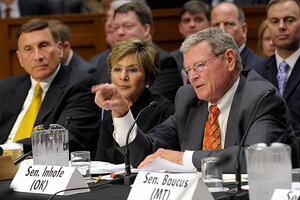Transportation bill, not yet passed, already blasted by critics
House and Senate negotiators are considering how to mesh two very different transportation bills, but experts and lobbyists say neither bill addresses the fundamental problems.

Sen. James Inhofe (R) of Oklahoma (right) speaks, as Sen. Barbara Boxer (D) of California (center) and Rep. John Mica (R) of Florida (left) listen, during the first meeting of the House and Senate conference on the transportation bill Tuesday on Capitol Hill in Washington.
Susan Walsh/AP
Washington
House and Senate negotiators may be weeks or even months away from reaching a compromise bill to fund America's transportation needs. But transportation experts don't need to wait for the final product, set to be hammered out by a conference committee beginning Tuesday afternoon. Whatever bill emerges, they say, will once again succeed only in kicking the can of sustainably funding American infrastructure down an ever-more-rutted road.
Bipartisan commissions have repeatedly suggested two crucial changes in how America pays for its infrastructure:
- A short-term increase in the gasoline tax to make sure US highway funding doesn’t go belly-up.
- A long-term plan for charging drivers directly for how many miles they drive.
Neither the House's basic 90-day extension of funding passed April 20, nor the Senate's more ambitious two-year plan passed March 14 addresses those suggestions. Until Congress is willing to consider such proposals, any transportation bill is merely papering over the cracks, say economic groups.
“We’re at a point where we’re at the ‘searching under the couch cushions’ portion of finding transportation funding as opposed to dealing directly with the question of user fees,” says Janet Kavinoky, executive director for transportation and infrastructure at the US Chamber of Commerce.
What’s wrong with America’s transportation situation? In large measure, it's the gas tax.
The federal gas tax is a primary means of funding highway construction and maintenance. The problem is that it is not indexed for inflation, so while road repair costs creep upward, the gas tax stays the same.
While that might be good news for American pocketbooks, it's devastating for America's highways. The tax was last increased in 1993, meaning that drivers are paying more than a third less into the Highway Trust Fund than they were at the beginning of the Clinton administration.
Moreover, the sluggish economy, high gas prices, and environmental concerns have led Americans to drive less and to buy more efficient vehicles. The lower demand for gasoline has further cut into federal taxes.
The result has been neglect of America's roadways, according to the National Surface Transportation Infrastructure Financing Commission. Its 2009 report suggests that the federal government needs to spend roughly $100 billion per year to maintain and improve its infrastructure. The Senate transportation bill offers $109 billion over two years.
“The gap between what we’re investing and what we need is just enormous,” says Rob Atkinson, former chairman of the NSTIFC. “And they make almost no effort to address that.”
The problem is that paying for American infrastructure more fully means raising taxes on someone.
One solution, pegging the gas tax to inflation – or raising it outright – would risk further angering Americans already angry about gas prices. A recent Washington Post/ABC News poll showed 65 percent of Americans disapprove of how President Obama has handled gasoline prices, compared with 26 percent who approve.
Another solution, perhaps even more promising to transportation experts, involves taxing drivers by the number of miles they drive – an idea known as a vehicle miles traveled system, or VMT. This ensures a stable funding stream even as drivers increasingly turn to hybrid and electric cars.
While there are many permutations of such a system, one method currently being piloted in Oregon will allow about 50 drivers to use a variety of devices to track how many miles they drive and charge them accordingly.
“The states as innovators will find the solution,” says Jim Whitty, manager of the division of the Oregon Department of Transportation group implementing the VMT pilot program this September, noting that Oregon was the first to pass a gas tax in 1919. “The key is to get the thing started” on the national level.
Getting a VMT system up and running could take 15 years, estimates Mr. Atkinson.
“That’s why people like myself have been urging Congress to be more proactive,” says R. Richard Geddes, a professor at Cornell University who served on a commission preceding the NSTIFC focused on transportation policy. Some cities, such as Stockholm, Singapore, and London" have started, he said, "but there really is no federal leadership on this.”
Still, the Senate bill sponsored by Sens. Barbara Boxer (D) of California and Jim Inhofe (R) of Oklahoma, which is touted as creating or maintaining as many as 1.8 million jobs, has merits, experts say.
- It significantly consolidates federal transportation programs from roughly 100 to a third as many.
- It speeds up the delivery of projects by cutting back on regulations.
- It offers more flexibility to states to partner with the private sector on infrastructure projects, particularly tolls.
- It eliminates the nearly 6,000 "pork-barrel" projects that riddled its most recent predecessor, among them the vaunted “bridge to nowhere” in Alaska.
- It heads off a massive downshift in federal aid for highway spending slated for the 2013 fiscal year, when funds would wither to $12.8 billion from $38.9 billion the previous year.
The shortfall is a parable of Congress's ad hoc approach to transportation funding.
Congress approved more projects than it could pay for in 2005, assuaging itself with a promise to consider how it could reform its transportation-funding mechanisms. No reforms followed, but a recession did, dramatically shrinking revenues in the trust fund. In 2008, Congress gave the fund a $35 billion infusion to keep it afloat, but that has now been chewed up, leaving the potential $26 billion shortfall next year.

